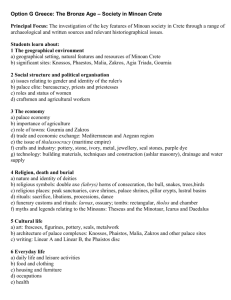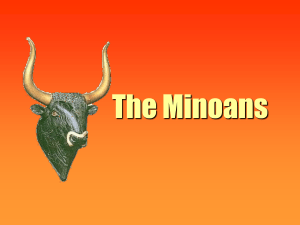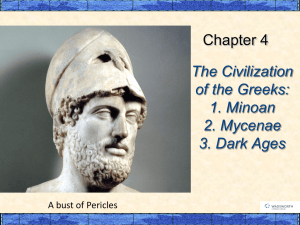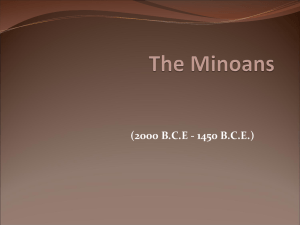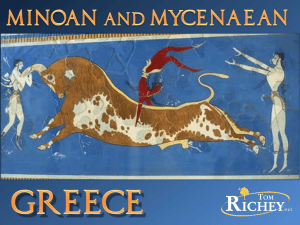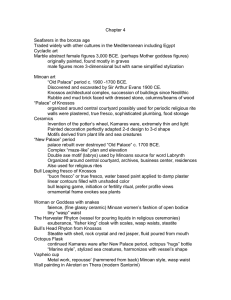THE FUNCTIONS OF A COSMOLOGICAL CENTER: KNOSSOS IN
advertisement
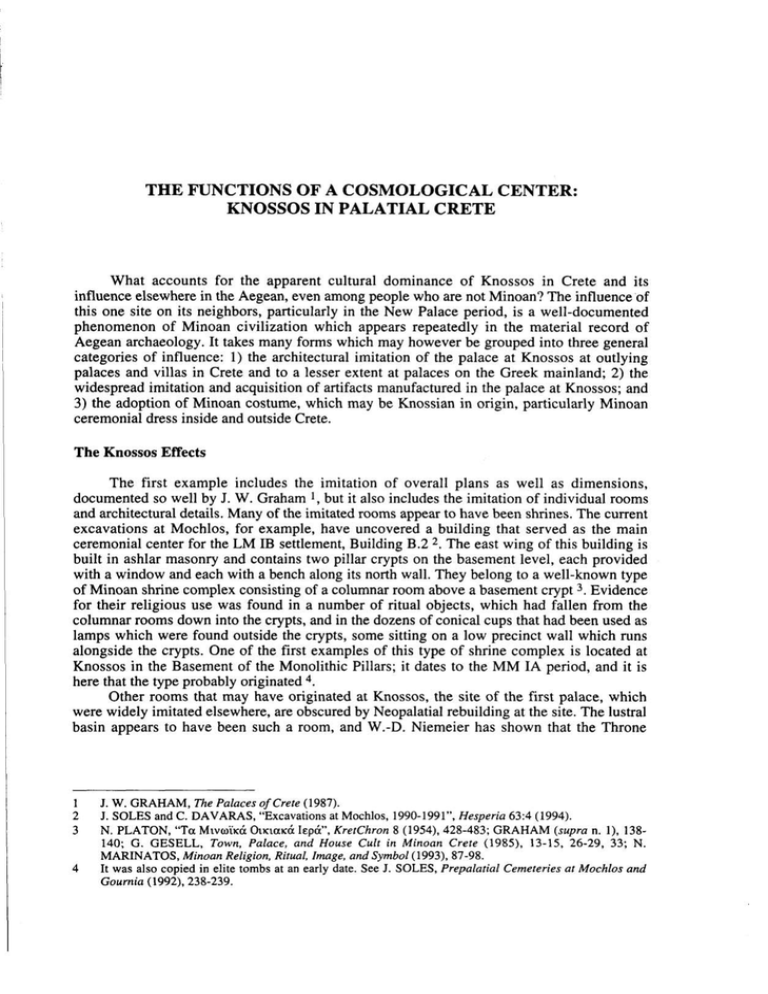
THE FUNCTIONS OF A COSMOLOGICAL CENTER: KNOSSOS IN PALATIAL CRETE What accounts for the apparent cultural dominance of Knossos in Crete and its influence elsewhere in the Aegean, even among people who are not Minoan? The influence'of this one site on its neighbors, particularly in the New Palace period, is a well-documented phenomenon of Minoan civilization which appears repeatedly in the material record of Aegean archaeology. It takes many forms which may however be grouped into three general categories of influence: 1) the architectural imitation of the palace at Knossos at outlying palaces and villas in Crete and to a lesser extent at palaces on the Greek mainland; 2) the widespread imitation and acquisition of artifacts manufactured in the palace at Knossos; and 3) the adoption of Minoan costume, which may be Knossian in origin, particularly Minoan ceremonial dress inside and outside Crete. ~ The Knossos Effects The first example includes the imitation of overall plans as well as dimensions, documented so well by J. W. Graham 1, but it also includes the imitation of individual rooms and architectural details. Many of the imitated rooms appear to have been shrines. The current excavations at Mochlos, for example, have uncovered a building that served as the main ceremonial center for the LM IB settlement, Building B.2 2. The east wing of this building is built in ashlar masonry and contains two pillar crypts on the basement level, each provided with a window and each with a bench along its north wall. They belong to a well-known type of Minoan shrine complex consisting of a columnar room above a basement crypt 3. Evidence for their religious use was found in a number of ritual objects, which had fallen from the columnar rooms down into the crypts, and in the dozens of conical cups that had been used as lamps which were found outside the crypts, some sitting on a low precinct wall which runs alongside the crypts. One of the first examples of this type of shrine complex is located at Knossos in the Basement of the Monolithic Pillars; it dates to the MM IA period, and it is here that the type probably originated 4. Other rooms that may have originated at Knossos, the site of the first palace, which were widely imitated elsewhere, are obscured by Neopalatial rebuilding at the site. The lustral basin appears to have been such a room, and W.-D. Niemeier has shown that the Throne 1 2 3 4 J. W. GRAHAM, The Palaces of Crete (1987). J. SOLES and C. DAVARAS, "Excavations at Mochlos, 1990-1991". Hesperia 63:4 (1994). N. PLATON, "Ta M ~ v o ' i ~ O d r ~ ~ t a IE~&", ~ d r KretChron 8 (1954),428-483; GRAHAM (supra n. l), 138140; G. GESELL, Town, Palace, and House Cult in Minoan Crete (1985), 13-15, 26-29, 33; N . MARINATOS, Minoan Religion, Ritual, Image, and Symbol (1993), 87-98. It was also copied in elite tombs at an early date. See J. SOLES, Prepalatial Cemeteries at Mochlos and Gournia (1992),238-239. 406 Jeffrey S. SOLES Room complex with its lustral basin, which originated in the Old Palace period according to S. MiriC, served as the model for a similar complex in Quartier Mu at Mallia 5. Architectural details, decorative schemes, and any number of pictorial fresco subjects found at Knossos are also widely imitated elsewhere. M. Wiener has discussed some of these and identified a "School of Knossos" whose architectural features include axial planning of important rooms, pier and door partitions, column bases, ashlar facades, and the use of gypsum from the Gypsades Hill 6 . One of the most important architectural imitations is the triglyph half-rosette frieze, which may have originated, as Niemeier has suggested, from the juxtaposition of throne and incurved altars in the Throne Room. It quickly reappears as a dado on the Tripartite Shrine and spreads throughout Crete. It might be argued that this architectural imitation is simply a Minoan architectural style, were it not that it extends outside Crete and continues after the fall of Knossos and the destruction of Minoan civilization when there are no longer any traces of the architecture in Crete itself. The Throne Room at Knossos may well have inspired the interior layout of the Mycenaean megaron, with throne to the right, especially at Tiryns where the pier and door partition in the aithousa and the triglyph half-rosette dado reflect this Minoan source 7, and the Grand Staircase at Knossos may have inspired the staircase alongside the megaron at Mycenae. The interior decoration of Mycenaean palaces is heavily influenced by Knossian prototypes: the griffins on either side of the Pylian throne, the tapering columns with Minoan capitals, the dados of stylized rock work, and various floor patterns are a few well-known examples. The second category of influence involves the imitation and acquisition of Knossian artifacts. Marine style pottery which is both imported and locally made in Crete is probably the best illustration since it defines every LM IB site on the island, and earlier styles of pottery from Knossos are already being acquired in the Old Palace period 8. Other types of Knossian artifacts are also eagerly sought in outlying parts of Crete. Building B.2 at Mochlos has now produced three large bronze basins which were imported from Knossos: two found in the western wing of the building in 1993 which are identical to one from the North West Treasury at Knossos and the third found on an upper story of this building in 1908 which is very similar 9. The list of such objects is long and includes many similar examples, such as seal stones, ivory figurines, stone vases, all skilfully crafted at Knossos, which become prized possessions in outlying parts of Crete or artists' models which are copied locally. They are also treasured and copied abroad; the Shaft Graves are full of such objects, as are many mainland tholos tombs 10. The Vapheio cups are especially good examples because they seem to have been fabricated at Knossos and also reproduce features of the palace at Knossos for pictorial display l . Like the architectural details of the palace, many such objects, 5 6 7 8 9 10 11 W.-D. NIEMEIER, "On the Function of the 'Throne Room' in the Palace at Knossos", in Function Palaces, 163-168; S . MIRIE, Das Thronraumareal des Palastes von Knossos. Versuch einer Neuinterpretation seiner Entstehung und seiner Funktion (1979). M. WIENER, "The Isles of Crete? The Minoan Thalassocracy Revisited", in Thera and the Aegean World 111. Proceedings of the Third International Congress held in Santorini, Greece September 3-9, 1989, I, Archaeology (1990), 128-160. On this point see also NIEMEIER (supra n. 5 ) , 167. This frieze at Tiryns is even carved from gypsum, which looks very much as if it were imported from Knossos. J. MACGILLIVRAY, "Pottery Workshops and the Old Palaces in Crete", in Function Palaces, 273-279. S. HOOD, The Arts in Prehistoric Greece (1978), 171, fig. 168. See 0.DICKINSON, who has recently called attention to these objects, "The Origins of Mycenaean Civilisation Revisited", in Transition. Le monde &glen du Bronze moyen au Bronze rbcent. Actes de la deuxibme Rencontre lglenne internationale de l'llniversitl de Libge (18-20 avril 1988), Aegaeum 3 (1989). 131-136. For their depiction of the frescos of the North Entrance, see PM 111, 177-185. THE FUNCTIONS OF A COSMOLOGICAL CENTER: KNOSSOS IN PALATIAL CRETE 407 acquired by the Mycenaeans, continue to be treasured into the IIIB and IIIC periods when Knossos is only a memory. Dress is a more problematic category since it is not certain that all Minoans did not dress the same. N. Marinatos has suggested that any woman of rank dressed in a costume with open bodice and flounced skirt, whether priestess, goddess or aristocrat, but the dress itself conformed to a prototype which was the dress of the Great Goddess 12. This explains why model faience dresses with crocuses are dedicated in the Temple Repositories at Knossos and why dresses also appear to have been venerated in scenes on seals; they represent the sacred dress of the Goddess. The costume also evokes Knossos where this goddess was worshipped and where large numbers of women wore her costume. Knossian textiles also appear to have been acquired by occupants of the Shaft Graves, many of them decorated with gold cut-outs of the goddess and the Tripartite Shrine, and after the conquest of Knossos and after its destruction this dress is still worn in Mycenaean palaces, if frescos provide reliable evidence, even in the north where it was probably somewhat impractical. Certain Mycenaean military regalia also made use of Knossian prototypes, including oxhide shields, Type A swords, perhaps even the inlaid daggers whose inlaid scenes copy Knossian fresco subjects 13. These imitations and acquisitions are related aspects of a phenomenon which M. Wiener has described as the "Versailles effect" 14 and illustrate the cultural dominance of Knossos in Crete and its strong appeal elsewhere in the Aegean. It is likely too that they represent only some part of that influence and that there were many other facets to Knossos's influence, particularly in the realm of song, music, dance, and poetry, which left no trace in the archaeological record. The processional scenes depicted at Knossos which reappear in frescos on Thera and the mainland hint at this wider influence. Knossos's influence is generally acknowledged, but there is considerable dispute about the nature of this influence and about the mechanisms at work in producing these effects. Some have suggested that its influence indicates political hegemony or colonization or at least the settlement of Minoans in more distant areas 15. Others have suggested that it is largely economic and that these effects are the by-products of trade in more valuable commodities between Knossos and outlying areas. Still others have suggested that highly-skilled, itinerant artisans travelled out from Knossos bringing their skills and expertise to less developed areas 16. Warfare and plunder might be factors, particularly in the acquisition of Knossian artifacts on the mainland. A prestige exchange mechanism might also be at work here, by which less developed elites in peripheral areas sought to consolidate their authority 17. All of these mechanisms may have played some role in promoting Knossos's influence, and they each have a certain validity as "mechanisms" of cultural dissemination, but they do not provide an adequate explanation for what is in effect a cultural transformation of Crete and many adjacent areas, all emanating from one site. They do not explain why the appeal of 12 13 14 15 16 17 MARINATOS (supra n. 3), 141-145. For the Cretan origin of inlaid daggers, see S. HOOD (supra n. 9), 177-182. For a sword-making workshop at Knossos, see J. DRIESSEN and C. MACDONALD, "Some Military Aspects of the Aegean in the Late 15th and Early 14th Centuries B.C.", BSA 79 (1984),49-74. M. WIENER, "Crete and the Cyclades in LM I: the Tale of the Conical Cups", in Thalassocracy, 17-25. WIENER (supra n. 6 ), with additional references. P. BETANCOURT, The History of Minoan Pottery (1985), 140; M. CAMERON, "Theoretical Interrelations among Theran, Cretan and Mainland Frescoes", in Thera and the Aeaean World, Papers Presented at the Second International Scientific Congress, Santorini Greece, August 1978 I (1978), 579592. As suggested by J. WRIGHT, "From Chief to King in Mycenaean Society", The Role of the Ruler in the Prehistoric Aegean. Proceedings of a Panel Discussion presented at the Annual Meeting of the Archaeological Institute of America, New Orleans, Louisiana, 28 December 1992, Aegaeum 1 1 (1994),6380. 408 Jeffrey S. SOLES Knossos is so strong. This appeal is an ideological phenomenon, and any explanation must take this fact into account and look into the minds of the people who were so strongly drawn to Knossos. Methodology In the absence of textual evidence, ethnography is probably the best tool that Aegean archaeologists have at their disposal to reconstruct details of the Minoan past. Ethnography enables archaeologists to identify patterns in prehistory which are meaningful in some larger way. Iconographic evidence may do the same, but ethnography has the advantage of also providing an explanation for these patterns. Relying on iconographic evidence alone, archaeologists are often unable to interpret the evidence at hand or must rely on a nonscientific, intuitive method to do so. Their interpretations may or may not be correct, but they often tend to be subjective. Ethnography, on the other hand, provides an explanation that is based on scientific observation, and with this explanation, it also provides detailed information which is often elusive in the archaeological data. If, for example, it is possible to identify evidence for social ranking in the mortuary record of Prepalatial Crete 18, then it is possible to postulate chiefdoms in this period, and from the ethnographic record to understand a lot more about the emergence of civilization in Crete. There is detailed, specific ethnographic information about chiefs and the roles they play, and it is possible to look for evidence in the archaeological record which confirms this information. At the same time, in the use of ethnographic data, it is important to remember that no one parallel is significant in itself, nor are the details of any particular parallel necessarily repeated from one culture to another; the truth lies only in the universal patterns that emerge from the comparative study of many different cultures. The Knossos effects described above belong to such a pattern, one that is welldocumented in the ethnographic records of numerous traditional and ancient societies. Architectural imitation of an elite center, acquisition and imitation of goods crafted in that center, and imitation of the regalia associated with that center are the indications in the ethnographic record that identify a superordinate center. Peripheral areas seek these very effects to indicate that they are in contact with these centers, that they possess objects that the elite center has created with special knowledge, objects of power, which become therefore symbols of status and demonstrate a privileged relationship with the elite center. In nonindustrial, traditional societies this elite center is nearly always a cosmological center. Ethnographic Parallels 19 "Every society links its own order to an order beyond itself, and, in the case of traditional societies, to the cosmos" 20. When Georges Balandier, the French anthropologist, wrote this, he had in mind certain African cultures whose chiefs act as mediators between their subjects and the supernatural powers in the order beyond. This is a well-known function of chiefs. They are linked both to 18 19 20 J. SOLES, "Social Ranking in Prepalatial Cemeteries", Problems, 49-61. In the parallels that follow, I have chosen for the most part examples from ancient civilizations which reached the same level of development as Minoan civilization. It is a small selection, and there are numerous additional parallels in the ethnographic literature, especially in contemporary, traditional societies. The reader who wishes to examine some of these should consult the works of Georges Balandier, Mary Helms and Mircea Eliade which are cited in the following discussion. G . BALANDIER, Political Anthropology (l970), 101. THE FUNCTIONS OF A COSMOLOGICAL CENTER: KNOSSOS IN PALATIAL CRETE 409 their personal ancestors and to the ancestors that make up the history of the chiefdom, and can serve as a link between their communities and the power-filled world of the ancestors who created their community. At the same time, as it formulates its links to the supernatural order, every society recognizes a geographically distinct place which serves as an interface or point of contact between this world and the world beyond. Mary Helms, the American anthropologist, has described these places "as foci of initial cultural origins and creation, and thus as places of cosmological power. They are perceived as settings for initial transformations, as ultimate sources of cultural benefits, as homes of deities, culture heroes, original skilled artisans, and ancestors, and as continuing fonts of energizing spirituality and of political-ideological legitimacy for the physically alive and active members of society" 21. Helms distinguishes between those centers that are located on a "vertical axis" of spatialltemporal distance outside man's reach and those that are located on a "horizontal axis" which involves real geographical distance that men can travel. The characteristics and activities of each are the same, however, and only the possibility for direct, physical contact differs. In a center that lies on a horizontal axis, skilled artisans produce goods that can be seen, imitated or acquired by those living in peripheral areas. Representatives from the center can travel into peripheral areas and those living in these areas can visit the center. Regardless of their location, however, these centers are seats of ancestral powers and powers associated with the origins of the culture. In a chiefdom or an unranked society, such centers are often localized in a natural setting, such as huge rocks, mountain tops, waterfalls, the headwaters of a river, forests or tall trees, but in a state-organized society these points acquire architectural reality. The beliefs of the Tewa Indians in the American Southwest are a good example of the first type 22. The Tewa recognize four sacred mountains, which are all visible from their village. The most sacred deities of the Tewa world live in lakes on the tops of these mountains. These lakes give access to the extraterrestrial universe and are the source of all the universal powers that benefit man. Teotihuacan is one of the best known examples in a more complex society. By 1500 A.D. when the Spanish conquistadores arrived in the New World, this city had been deserted forqearly 750 years, and yet it was still remembered in the Aztec tradition as a place of origin where the gods had gathered in the primordial darkness and created the world 23. They had debated who would become the sun and who the moon and two had sacrificed themselves in a great fire to bring light to the cosmos. Huge pyramids were raised for the sun and the moon, all in imitation of a sacred mountain which stood to the north of the city and represented the aniconic image of the Great Goddess of Teotihuacan. Nippur is another well-known example in a state-organized society, where the god Enlil, sitting in his palace, the Ekur, directed Enki to organize the earth according to his instructions 24. Babylon became the center in a later Mesopotamian tradition, and it was here at Bab-ilani, "the gate of the gods," that the gods descended to earth. Both cities were named the "Bond of Heaven and Earth". There was also a special link in the Babylonian concept between the city and the lower regions since the town was thought to have been built on the 21 22 23 24 M. HELMS, Crafr and the Kingly Ideal Art, Trade, and Power (1993). 173-191. M. HELMS, Ancient Panama, Chiefs in Search of Power (1979). 144-145. The story is preserved by Father BERNARDINO DE SAHAGUN, General History of the Things of New Spain. Florentine Codex (1575-1585), translated by A. ANDERSON and C. DIBBLE, vol. 3 (1952), 1; vol. 10 (1961). 191. For a description of Teotihuacan, see also R. ADAMS, Prehistoric Mesoamerica (1977). 190-204. The story is told in a Sumerian narrative poem, "Enki and the World Order". See the translation in S. KRAMER, The Sumerians, their History, Culture, and Character ( 1 963), 17 1 - 183. 410 Jeffrey S. SOLES waters of chaos which existed before the creation 25. It was linked therefore to the three cosmic zones: the heaven above, the earth, and the regions below. Mircea Eliade has noted in a number of books dealing with comparative religion that cultures which recognize a tripartite division of the cosmos into these three zones, as most Near Eastern civilizations did, invariably locate cosmological centers at the intersection of these zones 26. They are situated at the center of the cosmos and lie on an axis connecting the three zones which facilitates communication between them. The creation of the world often occurred at centers like Teotihuacan and Nippur, but this is not a necessary feature of all such centers. At many the cosmos has already been brought into being when the center is established, but the center is still a place of origin where the particular culture evolved. In the Shinto tradition of Japan, for example, the world had already come into being when Ninigi, the grandson of the sun goddess, Amaterasu, and the founding ancestor of the imperial family, descended from heaven. But the world was imperfect; disorder was rampant and things were not right. Ninigi's mission was to bring peace and order to the world, the benefits of civilization, and to build his palace, which would become a symbol of the divine presence on earth and a place of communication between heaven and earth 27. In the cosmogony of the Inca, Cuzco is only established after the creation 28. In the beginning the first Inca, Manco Capac, and his sister-wife, Mama Ocla, rose out of the waters of Lake Titicaca, at the bidding of their father, the Sun Viracocha. The Sun gave them a golden rod and instructed them to push it into the ground wherever they stopped to rest. When they reached a place where the rod sank deep into the earth and disappeared, they were to stop and settle and found the Kingdom of the Sun. The rod sank deep in the Cuzco Valley and here they founded the first settlement, calling it Cuzco, which means "navel of the world". As the homes of deities and the founding ancestors, located at the center of the world, these places become pilgrimage centers of primary importance. The mighty and the weak visit them in awe, in search of truth. Spanish colonial documents record that Moteczoma 11, a few years before the conquistadores arrived in the New World, was disturbed in his sleep by ill omens, and fearing the future, he left his capital at Tenochtitlan and travelled overland to the city of Teotihuacan 29. There he made sacrifices and communed with the gods, and in so doing he was following a long-established practice, for many Aztec emperors before him had made the same pilgrimage. The Jesuit priest Bemabe Cobo described the Inca city, Cuzco, as "the chief center and capital of their false religion and the most venerated sanctuary that these Indians had" 30. He wrote that "it was visited by all the people of the Inca Empire, who came to it out of devotion on pilgrimages". Its great temple was called Coricancha, "which means 'house of gold' because of the incomparable wealth of this metal which was embedded in the temple's chapels and walls, its ceiling and altars". It was dedicated to the Sun, although 25 26 27 28 29 30 M. ELIADE, The Myth of the Eternal Return (1954), 15. ELIADE (supra n. 25); Images and Symbols, Studies in Religious Symbolism (1961), 39-44; Patterns in Comparative Religion (1958), 367-378. The cosmology and the early history of Japan are described in two sacred Shinto texts, the Kojiki or Records of Ancient Matters and the Nihongi or Chronicles of Japan, both of which date to the 8th century A.D. and collect earlier oral traditions. For details, see J. FENTON, N. HEIN, F. REYNOLDS, A. MILLER and N. NIELSEN, Religions of Asia (1988), 244-279; and J. KITAGAWA, On Understanding Japanese Religion (1987), 139-173. The story of the Inca creation is told by GARCILASO DE LA VEGA, Comentarios reales de 10s Incas (1609). G. VAILLANT, Aztecs of Mexico (1941), 65. BERNABI? COBO, Inca Religion and Customs (1653), translated by R. HAMILTON (1990), 48-49. THE FUNCTIONS OF A COSMOLOGICAL CENTER: KNOSSOS IN PALATIAL CRETE 41 1 statues of other leading idols were placed in it, "for it served the same purpose as the Pantheon in Rome". As sources of cultural benefits, such centers are also places of esoteric knowledge and skilled crafting. These crafting skills are ancestor derived; the knowledge of crafting has been handed down from one generation to another from the beginning. Helms has noted that crafted goods which skilled crafters produce can have a transcendant quality, as music or song is said to have in many societies 31. They come from beyond the mind, from the world of the spirit. They also bring together this world in which men live and the outside world of the spirit, creator ancestors, and gods, the original creators. They join the two and create visible, tangible representations of this conjunction which may also "encapsulate" the powers of the outside world. Ethnographic literature and ancient texts identify many cosmological centers, like those cited here, but without written records, they are still easy to spot in the archaeological data because of the material effect they have on their surroundings. Cuzco was built in the shape of a crouching puma, with the hill that towers above the city to the north, Sacsahuaman, forming the feline's head, and the lower area to the south forming its body, with the great temple complex Coricancha located in the district known as Pumachupan (the puma's tail). Sacsahuaman served as a temple-fortress, the whole area forming a vast temple to the sun, rivalling the temple Coricancha at the opposite end of the city, but also providing quarters for the ruling family and its army together with their major storehouses. The Spaniards who occupied the Inca kingdom wrote that Cuzco served as a model for Inca cities; its grid system, its great open square, the royal lodgings with their multiple courtyards, even the shape of the puma, and especially Coricancha with its sun temple were imitated in every important city of the empire 32. Even towns of lesser importance contained replicas of Coricancha 33. In the same way the palace which Ninigi built for himself at Nara after his heavenly descent became the prototype for all Shinto shrines in Japan 34. Details of the palace, the pillared gates or torii that marked its boundaries, the stone lanterns that lined its paths, the forecourts, the vermilion paint on its varying structures, were reproduced in shrines throughout the land. Enki, when he organised the world at the bidding of Enlil, states that he brought craftsmanship to his own palace, the Abzu of Eridu, from the Ekur, the house of Enlil in Nippur 35. He puts the great builder of Enlil, Mushdamma, in charge of building all the houses in the land, and it is no accident then that all Sumerian temples resemble the temples of Eridu and Nippur with their buttressed walls, their altars, placed against one of the short walls, with an offering-table in front, and their entries located in one of the long walls, reached by stairs leading up to the platform on which the temple stands 36. Skilfully crafted goods made in these centers and the regalia associated with them are eagerly sought and imitated in outlying areas. The QuichC Maya who travelled to a center across the sea to seek political legitimacy returned with all the regalia of office - canopies, 31 32 33 34 35 36 HELMS (supra n. 21), 13-27. Huanuco, Vilcashuaman, Ollantaytambo are three examples of such cities. See J. HEMMINGS, Monuments of the Incas (1982). At Pisac, for example, the central group of buildings, known as the inti-huatana group after their stone bosses or "sun-fingers", are thought to have copied Coricancha with a sun temple and five rectangular chapels nearby. See HEMMINGS (supra n. 32), 89-91. K. TANGE and N. KAWAZOE, Ise, Prototype of Japanese Architecture (1965). KRAMER(supran.24), 173-175. H. FRANKFORT, The Art and Architecture of the Ancient Orient (1970), 2-5. The unique status of Nippur, seat of Enlil and the center of creation, but never the political capital of all Sumer, ensured a remarkably unified Sumerian culture by associating all Sumerian temples in a complex economic and scribal interdependence. 412 Jeffrey S. SOLES thrones, feet and feathers of birds, various ornaments - which they had acquired at the center 37. In like manner, Aztec emperors wore a distinctive turquoise diadem and a cloak decorated with a design of repeating blue squares or diamonds, each containing a dot, which P. Anawalt has recently traced back to their Toltec ancestors and to the gods at Tula which the Aztec regarded as second only to Teotihuacan as the birthplace of civilized life 38. She believes the peculiar motif of the cloaks was associated with the creator god Quetzalcoatl in particular who also had his pyramid at Teotihuacan. Shinto imperial regalia are associated with Ninigi who brought them with him when he descended from Heaven to rule on earth: a mirror thought to be the manifestation of his grandmother the sun goddess Amaterasu, a sword with which he might impose order, and comma-shaped jewels known as magatama 39. Housed in the palace at Nara, later removed to important shrines, they remain the official dress of the emperor today. In the production of imperial textiles and ceramics, the Inca created craft enclaves staffed by specialists who were trained to maintain the standards and specifications of the capital at Cuzco 40. The pottery included an array of distinctive shapes decorated primarily with geometric designs in polychrome paints, sometimes repeated in the textile patterns, which were designed to show the "unambiguous stamp of imperial manufacture". These specialists worked for the state and assured the high-quality and stylistic-integrity of sumptuary goods which were to be distributed to select members of the population for political and ideological purposes. The archaeological record offers many indications then that a site is serving as a cosmological center. Evidence for ritual performance is still another which will often appear in the archaeological data. It is a common component of many sites and will not be limited to cosmological centers by any means, but it is an essential characteristic of such centers, and since there is often a need to accommodate ritual performance on a larger scale here than in peripheral areas because of the large numbers of pilgrims who flock to such a site, the archaeological record will often reflect a difference in scale. Helms has pointed out that ritual performance enacts the nature of cosmic reality and thereby embodies that reality, including its supernatural powers, and makes them actual 41. It is the means by which a cosmological center facilitates communication between the supernatural world and this world and the means by which it asserts its control over the powers who reside in the supernatural world and brings them to bear on human affairs. In the Shinto tradition, ritual performance is a matter of bringing order to the cosmos through human action 42. Just as Amaterasu sought to promote order through her descendant the emperor, all humans seek to aid this process through ritual. In the court of Versailles or in the court of any high monarch, elaborate court fetes associate the exalted order of the monarch and the state with the exalted order and harmony of the cosmos 43. Ordinarily ritual performance employs music, song and dance, but it often also employs shamanism to communicate with the deity directly, especially at a cosmological center. The deity is thought to take possession of the shaman who falls into a trance and allows the deity to speak through him. There are many accounts of this phenomenon in the ethnographic literature 44. It is a common occurrence in Shinto religion where the shaman is usually a HELMS (supra n. 21), 195. P. ANAWALT, "Riddle of the Emperor's Cloak", Archaeology 46 (1993).30-36. H . KAGEYAMA, The Arts of Shinto (1973), 33-45. T. D'ALTROY, Provincial Power in the Inka Empire (1992), 178-183. HELMS (supra n. 21), 27. H . HARDACRE, Shinto and the State, 1868-1988 (1989), 100-1 13. R. STRONG, Splendor at Court (1973). See examples collected in M. ELIADE, Shamanism, Archaic Techniques of Ecstacy (1964). THE FUNCTIONS OF A COSMOLOGICAL CENTER: KNOSSOS IN PALATIAL CRETE 413 woman, sometimes a queen 45. This one from the 19th century describes a shamanic seizure during a mountain pilgrimage: All at once the hands holding the Shinto sacred wand began to twitch convulsively; the twitching rapidly increased to a spasmodic throe which momentarily grew more violent till suddenly it broke forth into the full fury of a superhuman paroxysm. It was as if the wand shook the man, not the man it. It lashed the air maniacally here and there above his head .... The look of the man was unmistakable. He had gone completely out of himself. The shaman is also an ancient phenomenon. Two of the most famous examples are found in the classical world in the Sibyls of Cumae and Delphi 46, and one of the best accounts of a shamanic seizure is found in Book VI of Virgil's Aeneid (11.77-102). In his book on shamanism, Eliade describes how the shaman works 47. Anyone can pray to the gods at a cosmological center or at a lesser shrine, and his prayers may or may not be heard, but a shaman alone has the power to traverse the different cosmic regions and actually come into the presence of the gods. The cosmological center provides an "opening" or "hole" to the axis that links the cosmic zones together, and "it is through this hole that the gods descend to earth and the dead to the subterranean regions; it is through the same hole that the soul of the shaman in ecstasy can fly up or down in the course of his celestial or infernal journeys" 48. Knossos's Identification as a Cosmological Center As a focus of cultural origins and home of original ancestors, Knossos is by definition a cosmological center. It is here that man first settled in Crete, and it is here that Minoan culture developed in the course of a long Neolithic period while the rest of the island remained largely uninhabited. Many of the activities associated with a cosmological center may therefore be associated with Knossos. This identification of Knossos has a number of interesting repercussions. It explains the Knossos effects noted at the beginning of the paper, as people attempted to reproduce or "encapsulate" the powers of the center in secondary locations. It clarifies the relationship of Knossos to outlying palaces in Crete which need not be thought of as political dependencies. It explains how a great civilization might wither away and die once its center has been seized by an alien culture. The identification lends support to the thesis of a ritual epiphany which H. Reusch first proposed in 1958 and which Niemeier elaborated upon in his article on the function of the Throne Room at Knossos 49. The ethnographic literature suggests that it is likely to have involved a shamanic seizure which fulfilled the ultimate purpose of a cosmological center when the Great Goddess spoke directly to mankind. It may explain certain features of Minoan palatial cult, particularly the pillar crypt with columnar shrine, and the sacred trees depicted on so many signet rings, which may have grown in the palace compound as well as the surrounding countryside. In the ethnographic literature pillars and trees serve as replicas of the cosmic order and reproduce the cosmic axis of the center so. The World Tree rises at the 45 46 47 48 49 50 W. FAIRCHILD, "Shamanism in Japan", Folklore Studies 21 (1962), 1-122. Varro in the Res Divinae lists ten different Sibyls in the classical world. ELIADE (supra n. 44), 259-287. ELIADE (supra n. 44), 259. NIEMEIER (supra n. 5). ELIADE (supra n. 44), 261-274; see also the ethnographic parallels cited in A. EVANS, "The Mycenaean Tree and Pillar Cult", JHS 21 (1901),99-204. Jeffrey S. SOLES 414 center of the earth, its roots reach to the underworld, and its upper branches touch the heavens. Shamans make their drums and staffs from the wood of these trees and use these objects to induce their trances. In a like manner, pillars stand in the underworld, the columns stand in this world and rise to the world above. In every culture where the World Pillar is found, prayers and sacrifices are made at the foot of the pillar since it opens the path to the heavens above. The lustral basin complex, which is distinctively Minoan and probably Knossian in origin, may be interpreted in the same way. The light well that rises above a lustral basin is an important element of this type of shrine; it stands in the same relation to the basin below as the column to its pillar. Both shrines reproduce architecturally the shaft of the cosmic axis which ordinary mortals and priests use to send offerings to the gods above and the gods below. Only the shaman also has the power to access this axis personally and use it to travel to the gods and acquire the knowledge she seeks. In the Throne Room at Knossos, where the epiphany of the goddess is thought to have occurred, the lustral basin, with its light well rising through the upper floors of the palace, provided that very "opening" which the shaman, sitting opposite on the throne, required to begin her ecstatic flight. Above all, the identification of Knossos as a cosmological center makes it possible to reconstruct a cosmogony for the Minoans which is also confirmed by good archaeological evidence 51. The details are lost, although one might imagine them from the many parallels offered above, but stripped to its essence, it would have gone something like this: In the beginning, about 8000 years ago, when the first man and woman rose from the sea and walked ashore onto the island of Crete, they wandered until they came to a hill above the Kairatos river. The Goddess guided their steps. This hill and its surrounding fields were fertile and well-watered. They recognised the soils with the best potential for their wheat and barley, where they might graze their sheep and goats, and they decided to settle here, calling the settlement Knossos. They were themselves unformed and knew little besides farming and sea-faring, but they were the first settlers and were honored as such, and what they learned they passed on to their children, and their children passed on what they learned to their children, until over the course of many centuries Minoan culture emerged. Knossos was the birthplace of this culture and for all who lived in the Aegean it was the navel of the world. Jeffrey S. SOLES 51 C. BROODBANK and T. STRASSER, "Migrant Farmers and the Neolithic Colonization of Crete", Antiquity 65 (1991), 233-245.
